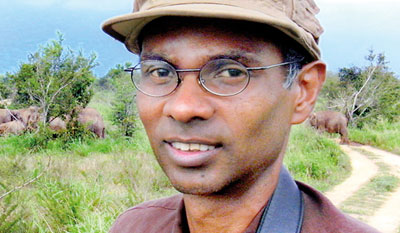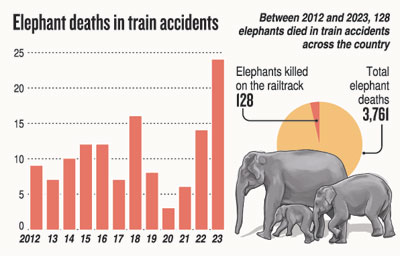News
Déjà vu – more elephants dead on the railtrack
View(s):- Scientist Dr. Prithiviraj Fernando takes a look at these tragedies and gives solutions
By Kumudini Hettiarachchi
For Sri Lankans, it is a tragic déjà vu – something that keeps happening. We lament, grit our teeth, bear it even though the stark images remain seared into our psyche for a while and then move on……….and it happens again!
It happened again on October 18 – a fuel train from Kolonnawa to Batticaloa hit a herd of elephants crossing the track at Minneriya early morn around 3.10 a.m., killing two on the spot and injuring at least another.

Dr. Prithiviraj Fernando
Will any remedial action be taken even now, is the critical question…..only time will tell.
The images of the mangled remains of the dead elephants and the injured elephant dragging its ravaged body after treatment, back to its herd was heart-wrenching.
The Sunday Times which has published in-depth articles on the need to redress the situation, once again asked Chairman of the Centre for Conservation and Research (CCR), Dr. Prithiviraj Fernando, a scientist who has done much research on wild elephants, for solutions to this tragedy.
Regarding the profile of the herd involved in this accident dubbed one of the worst, Dr. Fernando said that it is not possible to know which particular herd was involved, as there are many in the area. However, a number of herds in the area were collared under the Mahaweli Water Security and Investment Project (MWSIP) and one herd – that of Dewmi was actually close to the track at the time of the incident.
Sixty elephant collars have been funded by the Asian Development Bank (ADB) for the north-western and north-central areas under the MWSIP. One objective of the collaring is to identify road and rail crossing-points by elephants.
When asked whether the Department of Wildlife Conservation (DWC) and the Sri Lanka Railways (SLR) are aware of the routes used by wild elephants in the Minneriya area, he said that there is no ‘route’ as such, as the railtrack runs through elephant home ranges. So it is not necessarily that they were “going” somewhere, but elephants keep crossing the track back and forth in using their home range.

Radio-tracking data map courtesy of the CCR for the north-west and north-central areas particularly the Minneriya area – the black line indicates the railtrack and the red lines, the roads. The different coloured dots – tracking data from different elephants – collected some time ago
Whether action has been taken to prevent train-elephant collisions, he said that in a few places with identified crossings, the SLR had installed signposts imposing a 25km/h speed limit for trains but when checked at such a stretch in Galgamuwa, the speeds had been over 75km/h.
Dr. Fernando said that a comment to a media report on the latest incident had stated that there was a signpost indicating a speed limit of 20km/h at the location. However, the damage to the track and train and the grievous injuries to the elephants indicate that the train was ‘flying’!

A fuel train from Kolonnawa to Batticaloa hit a herd of elephants crossing the track at Minneriya early morn around 3.10 a.m., killing two on the spot and injuring at least another. Pic by Hiran Priyankara
Asked how Sri Lanka may halt a recurrence of these heartbreaking tragedies, he says that the dire need is to identify crossing-points and high-risk areas – which is best done through radio-tracking elephants. There is already data available for the north-west and north-central areas particularly the Minneriya area (see map courtesy of CCR), with more becoming available in the next years through the MWSIP collars.
“Where there is no tracking data, we can use past ‘incident’ data. Recently Colombo University’s Tanya Karunasena did a study on elephant train accidents on the north-west and north-central lines, identifying ‘hot-spots’ based on past incident data,” Dr. Fernando added.
| Action to prevent elephant deaths on the tracks Measures to prevent elephant-train accidents, according to Dr. Prithiviraj Fernando are: Identify crossing-points and high-risk areas based on radio-tracking data and where such data are not available on past-incident data. Limit trains ‘not essential to travel through the night’ such as goods trains through those areas to day-time only. Impose night-time speed limits through those areas for essential ones such as passenger trains as almost all accidents occur in the night. If a high-risk area is ‘hilly’ and trains speed through it to preserve momentum to climb a gradient, instead use more powerful engines/less load per train so that slow speeds can be maintained. However, this is unlikely to be an issue as train-elephant accidents are all in the lowlands. When comparing the gradient that up-country trains climb, the ‘hills’ in the north-west and north-central areas where most incidents happen, are ‘mole hills’. Where night-time speed limits are imposed for trains, the DWC/Police should check the speed with a speed-gun or instal speed cameras on such stretches and prosecute offenders. Construct overpasses and elevated tracks for trains or underpasses for elephants at crossing-points and high-risk areas. This would be the best solution but is expensive and takes time. Dr. Fernando was specific that electric fences or other barriers to prevent elephants crossing tracks are not a solution by themselves. Electric fences could be used to advantage in combination with underpasses, as otherwise, such fences if not located correctly will do much more harm. “If fences or barriers obstruct elephant movement within their home ranges, by trying to save a few who may be hit by trains, we will kill many, many more by starving them to death and increased human-elephant conflict. Therefore, location of underpasses and installation of fences should only be based on radio-tracking data and continuous monitoring,” he added.
| |
| Dead in their prime!From Minneriya, the Sunday Times, found that the dead were two young-adult female elephants, while a juvenile calf was injured. The calf had been seen limping but walked away a few hours after the accident. It had been observed stopping and grazing on the grasslands before going into the jungle and sources said that if it had been injured badly, it is most unlikely to have been grazing. |
The best way to say that you found the home of your dreams is by finding it on Hitad.lk. We have listings for apartments for sale or rent in Sri Lanka, no matter what locale you're looking for! Whether you live in Colombo, Galle, Kandy, Matara, Jaffna and more - we've got them all!

